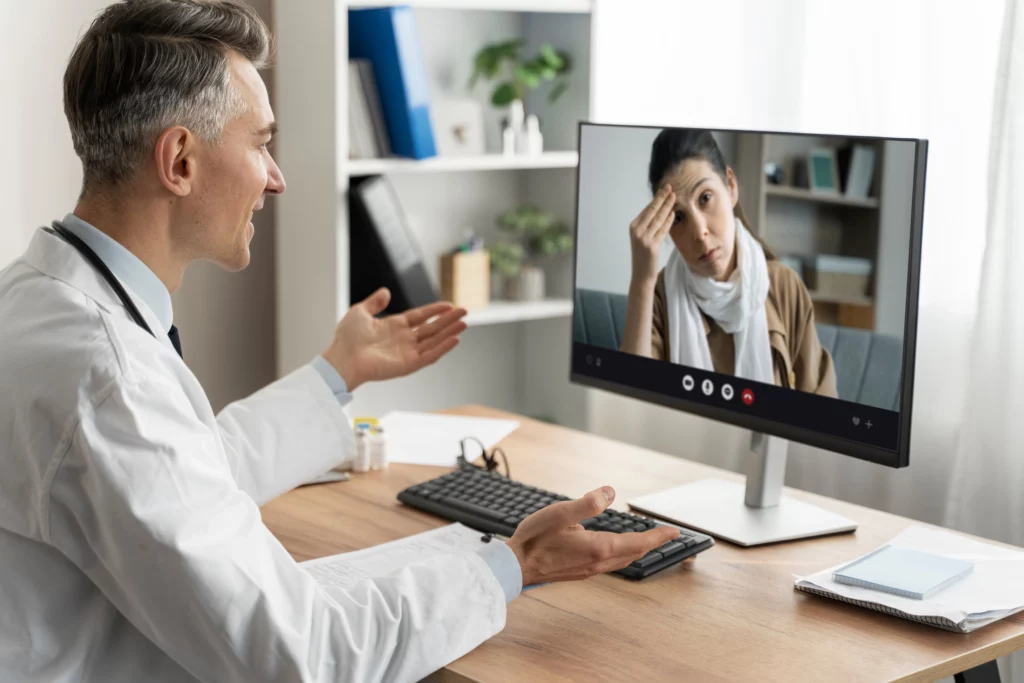
Virtual Medical Scribe Using a virtual medical scribe frees physicians from clerical tasks and allows them more time for patient care and building meaningful relationships.
Effective physician-patient communication is crucial for building strong relationships and improving healthcare outcomes. However, the increasing time spent on Electronic Health Records (EHRs) has shifted physicians’ priorities, often at the expense of meaningful patient interactions. A study reveals that EHR demands can negatively impact physician-patient relationships and communication, potentially eroding the human connection that initially drew physicians to their profession. Are you missing that human connection? Embracing virtual medical scribes not only relieves the burden of EHR documentation but also enhances the physician-patient relationship, leading to better quality care and improved health outcomes. Yes, the use of scribes not only streamlines documentation but also reinstates the joy of practicing medicine by bringing back the essential human connection.
Enhancing the Physician-Patient Connection through Virtual Medical Scribes
The physician-patient relationship holds immense significance in healthcare as patients value the time, attention, and empathy they receive during hospital visits. For physicians, connecting with patients involves making eye contact, actively listening, and understanding emotional cues to establish a meaningful bond. However, the demands of Electronic Health Records (EHRs) can interfere with this essential connection. When physicians are preoccupied with navigating EHRs and documenting patient histories on their computer screens, they may miss opportunities to fully engage with their patients. Integrating virtual medical scribes into the healthcare workflow offers a solution to overcome the interference caused by EHR documentation. By delegating the task of charting to a virtual medical scribe, physicians can dedicate their full attention to listening and connecting with their patients. Moreover, the absence of a physical scribe in the exam room helps patients feel more at ease, encouraging them to openly discuss even sensitive medical issues without reservation. This fosters a deep sense of connection and building stronger relationships with their healthcare providers.
The Challenges: Balancing EHRs and Patient Care
The act of charting patient information into EHRs while simultaneously conversing with patients presents challenges. Physicians often find themselves torn between focusing on their computer screens and paying undivided attention to the patient in front of them. This multitasking can create a sense of hurriedness during patient visits, leaving patients feeling unheard and less satisfied with their healthcare experience. The limited time available for each appointment further exacerbates the situation, making it difficult for physicians to establish the necessary rapport with their patients. By taking the help of a virtual medical scribe to document patient visits, physicians can fully dedicate their time and attention to providing care for their patients. With scribes handling the EHR burden, physicians can allocate more time to interact with their patients, which makes building a strong physician-patient relationship easier. This, in turn, improves patient satisfaction and the overall quality of care provided. Patients feel valued when they sense that their physician is genuinely attentive to their concerns, leading to improved physician-patient relationships.
Exploring the Impact of Medical Scribes on the Physician-Patient Relationship
Various studies have investigated the role of medical scribes in enhancing the physician-patient relationship, shedding light on their positive effects.
In an academic General Internal Medicine (GIM) setting, the incorporation of scribes showed promising results. Physicians reported increased satisfaction with their work, finding relief from the burden of documentation. However, this improvement in physician satisfaction did not come at the expense of patient satisfaction, indicating that patients remained content with their overall healthcare experience.
A quasi-experimental pilot study focused on understanding the influence of scribes on physician-patient communication in a primary care setting. The findings were promising with patients expressing high levels of satisfaction with their interactions with physicians. This suggests that the presence of scribes positively impacted communication, leading to more meaningful and productive patient visits.
Furthermore, a study published in the ClinicoEconomics and Outcomes Research Journal by Dove Medical Press explored the benefits of medical scribes in a cardiology clinic. Apart from improving physician productivity, the study also emphasized the significant impact of scribes on physician-patient interactions. This outcome further supports the idea that scribes contribute to fostering positive and empathetic connections between physicians and patients.
In conclusion, virtual medical scribes play a vital role in re-establishing the human connection in medicine. By offloading EHR documentation tasks, physicians can dedicate more time to their patients, improving the quality of care and patient satisfaction. The use of scribes has been shown to enhance physician-patient communication in various healthcare settings, leading to positive outcomes. Embracing virtual medical scribes is a proactive step towards enhancing the healthcare experience for both physicians and patients, ultimately contributing to a more compassionate and effective healthcare system.
